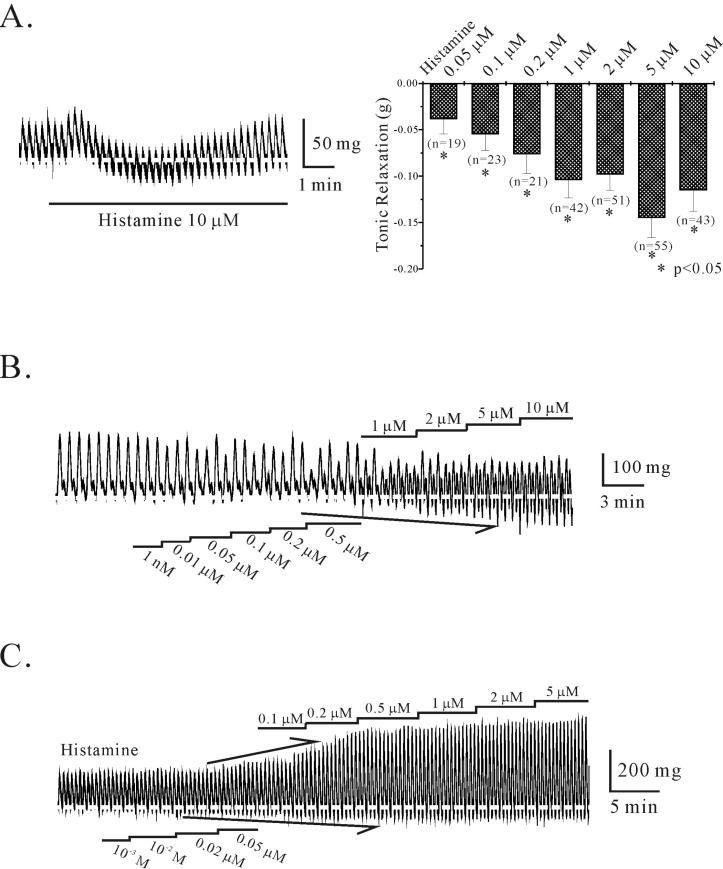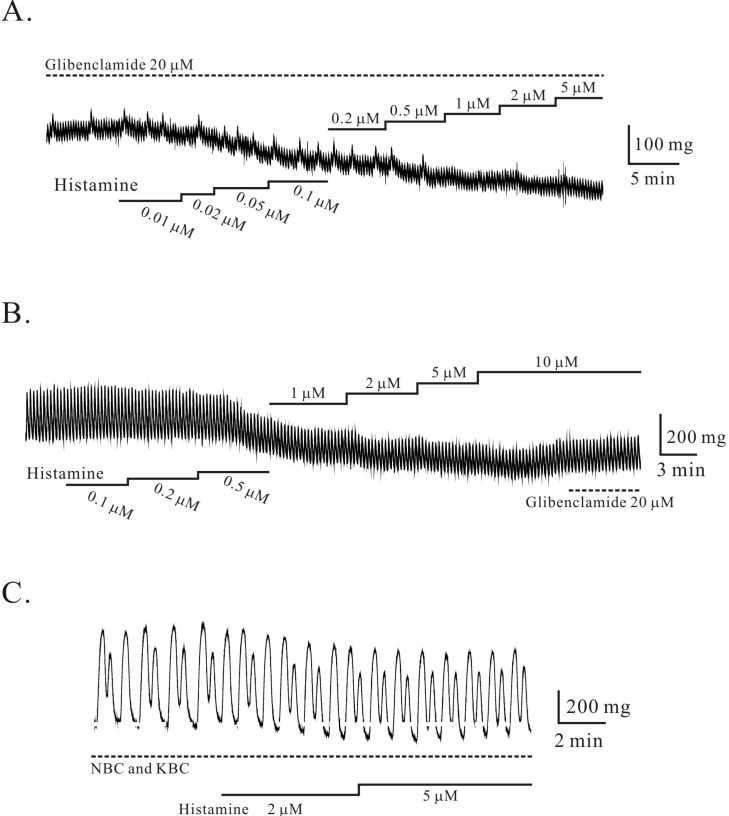Korean J Physiol Pharmacol.
2014 Oct;18(5):425-430. 10.4196/kjpp.2014.18.5.425.
H2 Receptor-Mediated Relaxation of Circular Smooth Muscle in Human Gastric Corpus: the Role of Nitric Oxide (NO)
- Affiliations
-
- 1Department of Surgery, Konyang University Hospital, Daejeon 302-718, Korea.
- 2Department of Surgery, Chungbuk National University College of Medicine, Cheongju 361-763, Korea. yunhyo@chungbuk.ac.kr
- 3Department of Physiology, Chungbuk National University College of Medicine, Cheongju 361-763, Korea. physiokyc@chungbuk.ac.kr
- 4Department of Internal Medicine, Chungbuk National University College of Medicine, Cheongju 361-763, Korea.
- 5Department of Pharmacology, Chungbuk National University College of Medicine, Cheongju 361-763, Korea.
- 6Department of Pathology, Chungnam National University School of Medicine, Daejeon 305-764, Korea.
- 7Department of Pathology, Chungbuk National University College of Medicine, Cheongju 361-763, Korea.
- 8Department of Otolaryngology, Seoul National University, Borame Medical Center, Seoul 156-707, Korea.
- 9Department of Preventing Medicine, Chungbuk National University College of Medicine, Cheongju 361-763, Korea.
- 10Department of Physiology, College of Medcine, Shanghai Jiaotong University, Shanghai 200240, P.R. China.
- KMID: 2285542
- DOI: http://doi.org/10.4196/kjpp.2014.18.5.425
Abstract
- This study was designed to examine the effects of histamine on gastric motility and its specific receptor in the circular smooth muscle of the human gastric corpus. Histamine mainly produced tonic relaxation in a concentration-dependent and reversible manner, although histamine enhanced contractility in a minor portion of tissues tested. Histamine-induced tonic relaxation was nerve-insensitive because pretreatment with nerve blockers cocktail (NBC) did not inhibit relaxation. Additionally, K+ channel blockers, such as tetraethylammonium (TEA), apamin (APA), and glibenclamide (Glib), had no effect. However, N(G)-nitro-L-arginine methyl ester (L-NAME) and 1H-(1,2,4)oxadiazolo (4,3-A) quinoxalin-1-one (ODQ), an inhibitor of soluble guanylate cyclase (sGC), did inhibit histamine-induced tonic relaxation. In particular, histamine-induced tonic relaxation was converted to tonic contraction by pretreatment with L-NAME. Ranitidine, the H2 receptor blocker, inhibited histamine-induced tonic relaxation. These findings suggest that histamine produced relaxation in circular smooth muscle of human gastric smooth muscle through H2 receptor and NO/sGC pathways.
Keyword
MeSH Terms
-
Apamin
Glyburide
Guanylate Cyclase
Histamine
Humans
Muscle, Smooth*
Nerve Block
NG-Nitroarginine Methyl Ester
Nitric Oxide*
Ranitidine
Receptors, Histamine H2
Relaxation*
Tetraethylammonium
Apamin
Glyburide
Guanylate Cyclase
Histamine
NG-Nitroarginine Methyl Ester
Nitric Oxide
Ranitidine
Receptors, Histamine H2
Tetraethylammonium
Figure
Reference
-
1. Dy M, Schneider E. Histamine-cytokine connection in immunity and hematopoiesis. Cytokine Growth Factor Rev. 2004; 15:393–410. PMID: 15450254.
Article2. Rangachari PK. The fate of released histamine: reception, response and termination. Yale J Biol Med. 1998; 71:173–182. PMID: 10461350.3. Shahid M, Tripathi T, Sobia F, Moin S, Siddiqui M, Khan RA. Histamine, histamine receptors, and their role in immunomodulation: an updated systematic review. Open Immunol J. 2009; 2:9–41.
Article4. Hill SJ. Distribution, properties, and functional characteristics of three classes of histamine receptor. Pharmacol Rev. 1990; 42:45–83. PMID: 2164693.5. Parsons ME, Ganellin CR. Histamine and its receptors. Br J Pharmacol. 2006; 147(Suppl 1):S127–S135. PMID: 16402096.
Article6. Stark H. Histamine receptors. Biotrend Rev. 2007; 1:1–6.7. Muller MJ, Prior T, Hunt RH, Rangachari PK. H1 contractile and H2 relaxant receptors in canine gastric muscularis mucosae. Life Sci. 1993; 52:PL49–PL53. PMID: 8429755.8. Ohga A, Taneike T. H1- and H2-receptors in the smooth muscle of the ruminant stomach. Br J Pharmacol. 1978; 62:333–337. PMID: 638312.9. Kim H, Dwyer L, Song JH, Martin-Cano FE, Bahney J, Peri L, Britton FC, Sanders KM, Koh SD. Identification of histamine receptors and effects of histamine on murine and simian colonic excitability. Neurogastroenterol Motil. 2011; 23:949–e409. PMID: 21806740.
Article10. Kim YC, Choi W, Yun HY, Sung R, Yoo RY, Park SM, Yun SJ, Kim MJ, Song YJ, Xu WX, Lee SJ. Nitric oxide-mediated relaxation by high K+ in human gastric longitudinal smooth muscle. Korean J Physiol Pharmacol. 2011; 15:405–413. PMID: 22359479.11. Kim DH, Kim YC, Choi W, Yun HY, Sung R, Kim HS, Kim H, Yoo RY, Park SM, Yun SJ, Song YJ, Xu WX, Lee SJ. High K+-induced relaxation by nitric oxide in human gastric fundus. Korean J Physiol Pharmacol. 2012; 16:297–303. PMID: 23118553.12. Kim YC, Choi W, Sung R, Kim H, You RY, Park SM, Youn SJ, Kim MJ, Song YJ, Xu WX, Lee SJ, Yun HY. Relaxation patterns of human gastric corporal smooth muscle by cyclic nucleotides producing agents. Korean J Physiol Pharmacol. 2009; 13:503–510. PMID: 20054499.
Article13. Yun HY, Sung R, Kim YC, Choi W, Kim HS, Kim H, Lee GJ, You RY, Park SM, Yun SJ, Kim MJ, Kim WS, Song YJ, Xu WX, Lee SJ. Regional distribution of interstitial cells of cajal (ICC) in human stomach. Korean J Physiol Pharmacol. 2010; 14:317–324. PMID: 21165331.
Article14. Gokina NI, Bevan JA. Histamine-induced depolarization: ionic mechanisms and role in sustained contraction of rabbit cerebral arteries. Am J Physiol Heart Circ Physiol. 2000; 278:H2094–H2104. PMID: 10843909.15. Gokina NI, Bevan JA. Role of intracellular Ca2+ release in histamine-induced depolarization in rabbit middle cerebral artery. Am J Physiol Heart Circ Physiol. 2000; 278:H2105–H2214. PMID: 10843910.16. Kim YC, Sim JH, Kang TM, Suzuki H, Kim SR, Kwon SC, Xu WX, Lee SJ, Kim KW. Sodium-activated potassium current in guinea pig gastric myocytes. J Korean Med Sci. 2007; 22:57–62. PMID: 17297252.
Article17. Park JK, Kim YC, Sim JH, Choi MY, Choi W, Hwang KK, Cho MC, Kim KW, Lim SW, Lee SJ. Regulation of membrane excitability by intracellular pH (pHi) changers through Ca2+-activated K+ current (BK channel) in single smooth muscle cells from rabbit basilar artery. Pflugers Arch. 2007; 454:307–319. PMID: 17285302.18. Cardell LO, Edvinsson L. Characterization of the histamine receptors in the guinea-pig lung: evidence for relaxant histamine H3 receptors in the trachea. Br J Pharmacol. 1994; 111:445–454. PMID: 7911715.
Article19. Bolton TB. Mechanisms of action of transmitters and other substances on smooth muscle. Physiol Rev. 1979; 59:606–718. PMID: 37533.
Article20. Karashima T, Kuriyama H. Electrical properties of smooth muscle cell membrane and neuromuscular transmission in the guinea-pig basilar artery. Br J Pharmacol. 1981; 74:495–504. PMID: 6274466.
Article21. Sander LE, Lorentz A, Sellge G, Coëffier M, Neipp M, Veres T, Frieling T, Meier PN, Manns MP, Bischoff SC. Selective expression of histamine receptors H1R, H2R, and H4R, but not H3R, in the human intestinal tract. Gut. 2006; 55:498–504. PMID: 16299042.
Article22. Diaz J, Vizuete ML, Traiffort E, Arrang JM, Ruat M, Schwartz JC. Localization of the histamine H2 receptor and gene transcripts in rat stomach: back to parietal cells. Biochem Biophys Res Commun. 1994; 198:1195–1202. PMID: 8117277.23. Lovenberg TW, Pyati J, Chang H, Wilson SJ, Erlander MG. Cloning of rat histamine H(3) receptor reveals distinct species pharmacological profiles. J Pharmacol Exp Ther. 2000; 293:771–778. PMID: 10869375.24. Oda T, Morikawa N, Saito Y, Masuho Y, Matsumoto S. Molecular cloning and characterization of a novel type of histamine receptor preferentially expressed in leukocytes. J Biol Chem. 2000; 275:36781–36786. PMID: 10973974.
Article25. Bytzer P. H2 receptor antagonists and prokinetics in dyspepsia: a critical review. Gut. 2002; 50:iv58–iv62. PMID: 11953351.26. Yu YC, Guo HS, Li Y, Piao L, Li L, Li ZL, Xu WX. Role of calcium mobilization in sodium nitroprusside-induced increase of calcium-activated potassium currents in gastric antral circular myocytes of guinea pig. Acta Pharmacol Sin. 2003; 24:819–825. PMID: 12904283.27. Ibba Manneschi L, Pacini S, Corsani L, Bechi P, Faussone-Pellegrini MS. Interstitital cells of Cajal in the human stomach: distribution and relationship with enteric innervation. Histol Histopathol. 2004; 19:1153–1164. PMID: 15375758.28. Tonini M, De Giorgio R, De Ponti F, Sternini C, Spelta V, Dionigi P, Barbara G, Stanghellini V, Corinaldesi R. Role of nitric oxide- and vasoactive intestinal polypeptide-containing neurones in human gastric fundus strip relaxations. Br J Pharmacol. 2000; 129:12–20. PMID: 10694197.
Article29. Iino S, Horiguchi K, Nojyo Y. Interstitial cells of Cajal are innervated by nitrergic nerves and express nitric oxide-sensitive guanylate cyclase in the guinea-pig gastrointestinal tract. Neuroscience. 2008; 152:437–448. PMID: 18280665.
Article30. Kim YC, Suzuki H, Xu WX, Choi W, Kim SH, Lee SJ. Ca2+-activated K+ current in freshly isolated c-Kit positive cells in guinea-pig stomach. J Korean Med Sci. 2009; 24:384–391. PMID: 19543421.31. Kim YC, Suzuki H, Xu WX, Hashitani H, Choi W, Yun HY, Park SM, Youn SJ, Lee SJ, Lee SJ. Voltage-dependent Ca current identified in freshly isolated interstitial cells of cajal (ICC) of guinea-pig stomach. Korean J Physiol Pharmacol. 2008; 12:323–330. PMID: 19967074.32. Nemeth L, Puri P. Three-dimensional morphology of c-Kit-positive cellular network and nitrergic innervation in the human gut. Arch Pathol Lab Med. 2001; 125:899–904. PMID: 11419974.
Article33. Sung R, Kim YC, Yun HY, Choi W, Kim HS, Kim H, Lee KJ, You RY, Park SM, Youn SJ, Kim MJ, Kim WS, Song YJ, Kim SY, Xu WX, Lee SJ. Interstitial cells of Cajal (ICC)-like-c-Kit positive cells are involved in gastritis and carcinogenesis in human stomach. Oncol Rep. 2011; 26:33–42. PMID: 21573494.
Article
- Full Text Links
- Actions
-
Cited
- CITED
-
- Close
- Share
- Similar articles
-
- The Role of Nitric Oxide in the Relaxation of Canine Corpus Cavernosum Smooth Muscle
- Effects of Adenosine Triphosphate on Relaxation of Rabbit Cavernosal Smooth Muscle
- Experimental study of the role of nitric oxide of cavernous smooth muscle relaxation
- Relaxation Response of Rabbit Cavernous Smooth Muscle to Estrogen
- Mechanism of Action of Endothelium-Dependent Relaxation Substances on Rabbit Corpus Cavernosum





